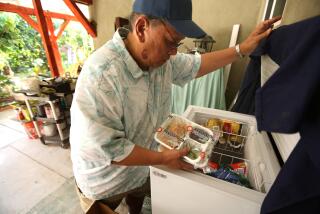If ‘Decent Provision for the Poor’ Is the Test, We Flunk
- Share via
Winter has finally caught up with Southern California. The Santa Anas that kept us unseasonably warm for most of the last two months are gone, replaced by cold winds and periods of pounding rain.
This is a good time to discuss the “social safety net” of welfare programs, which is supposed to catch those who fall out of the economy before they land on the cold concrete. In Los Angeles County there is plenty of evidence that the safety net is tattered, and that many people are falling through the holes.
Each month about 10,000 destitute people apply to Los Angeles County for help. Of these, about 5,000 are homeless at the time they apply. These are not “snowbirds,” here in search of our more moderate climate. In fact, county statistics show that the average recipient of general relief, or county welfare, has lived here 24 years.
General relief is the lowest level of the social safety net. Funded entirely by the county, it provides recipients with a monthly allowance of $228. Persons who have any resources or who are eligible for any other benefit program are ineligible for general relief.
About half the people who receive general relief are physically or mentally disabled and are not required to do labor in exchange for the money that they receive. The other half are required to perform menial tasks at county facilities--to “work off” the $228 “grant.” They clean county beaches, mop hallways in county buildings and tend furnaces at the county crematorium, which disposes of the earthly remains of the county’s poor.
But the workfare labor is the least of the burdens of being on general relief. The real struggle is the attempt to survive in Los Angeles on $228 per month.
The grant is supposed to be based on objective criteria as to what it costs to survive--not survive well, but just survive--in Los Angeles County. Since 1981 the Board of Supervisors has refused to increase the amount, citing budgetary constraints.
The $228 total is the sum of three components in a “basic budget table,” which provides $74 for food, $11 for clothing and all other personal needs, and $143 for housing. The fact is that there is no housing at $143 per month in Los Angeles County. Even an 8-foot-by-10-foot room on Skid Row, without heat or running water, costs an average of $240 a month.
As a result, the 35,000 people now on general relief fall into two broad categories: those who are homeless at least a part of each month because they can’t pay a full month’s rent, and those who avoid homelessness by spending all their money on rent and all their time trying to eat in soup lines.
For those forced to spend a week or two of each month on the street, the result is illness, violence and sometimes death. Almost none compelled to live on the streets for more than a few days avoid being assaulted. Private medical clinics that attempt to serve the poor are full of people with severely swollen feet and legs--the result of fluid that accumulates in the lower extremities when the homeless spend endless hours standing in soup lines and nights spent sitting up in missions and all-night theaters. One night in a cold rain can lead to severe hypothermia--reduced core body temperature. The members of the Board of Supervisors who have prevented any increase in subsistence payments to the very poor may be proud of the money that they have saved. But their calculations do not include the $600 that it costs taxpayers when a general-relief recipient ends up in the emergency room at County-USC. Nor do the calculations tell the entire story in other ways.
Men and women who were once ordinary and independent working-class people are slowly converted by the general-relief program into a hopeless and unemployable underclass. When your entire existence is consumed with finding food and a safe place to spend the night, there is little energy left to look for work. And when you look for work, as the county requires general-relief recipients to do, it is a rare employer who will hire someone carrying the visible marks of a desperate existence. Even if the budgetary bottom line were the only thing that mattered, the general-relief system would be an abysmal failure.
But general relief is also a failure in a much more important sense. It was a very conservative Englishman, Samuel Johnson, who said: “A decent provision for the poor is the true test of civilization.” We in Los Angeles County are failing that test. The estimated 32,800 homeless people in Los Angeles County who make this the “homeless capital” of America include thousands who can trace their predicament to the direct result of little-noticed votes taken by the Board of Supervisors regarding the general-relief program.
It is apparently the judgment of Supervisors Deane Dana, Mike Antonovich and Pete Schabarum that their constituents are either unaware of or indifferent to the plight of the poor and the homeless. But even in this conservative time it is hard to believe that most people can know the facts and remain indifferent. The alternative is ominous: If we are willing to accept the fact that we consign poor people to live in alleys and parks, what will we not accept?
More to Read
Sign up for Essential California
The most important California stories and recommendations in your inbox every morning.
You may occasionally receive promotional content from the Los Angeles Times.










